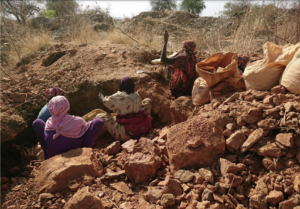WHO may shut down Sudan health facilities
Dozens of health facilities supported by the World Health Organization in strife-torn areas of Sudan risk closure due to a lack of funds, exposing one million people to epidemics.
Dozens of health facilities supported by the World Health Organization in strife-torn areas of Sudan risk closure due to a lack of funds, exposing one million people to epidemics. Large international organisations are changing funding tactics: “We have to find resources within Sudan.”
Eleven clinics have already been shut in Darfur, Blue Nile and South Kordofan where millions of people have been displaced or fled years of fighting between government troops and armed movements.
As an acute cash crunch worsens and with the world's eyes focused on other conflicts such as Syria, another 49 facilities in these regions are also at risk, the WHO head in Sudan, Naeema El Gasseer, told AFP.
“We don't have enough funds to continue supporting clinics in remote areas that provide people with health services,” Gasseer said. “Another 49 are facing closure. We are talking about a million people who can be affected.”
The closures could impact immunisation services, while some 323,000 women of child-bearing age and children under five will lack access to health care, she said. “A heightened risk of epidemics is likely […] with people having to travel long distances to access available health care services,” El Gasseer said.
WHO, a United Nations agency, needs about $7 million to operate these clinics over the next year, but is having trouble sourcing the funds. More than half of these facilities are in Sudan's western region Darfur, where more than 2.5 million people have been displaced. Years of conflict in South Kordofan and Blue Nile has displaced more than 600,000 people.
Sudan is also host to over 25 per cent of all South Sudanese who have fled the conflict in their country in search of refuge: over a quarter million people.
Phasing out
Funding for Sudan's health care sector has fallen in the past two or three years. The cash crunch now faced by WHO and other NGOs is severe: many clinics have no money to buy medicines or to pay staff wages. “Sudan is like a forgotten emergency,” said Adil El Mahi from Save the Children Sweden, which operates health facilities for children in the conflict zones.
Save the Children Sweden is one of the organisations phasing out health and nutrition services in 20 centres in South Kordofan, affecting about 200,000 people who it has supported.
The United Nations had launched a global appeal to raise $952 million to fund humanitarian needs in Sudan in 2016. A “significant” 55 per cent of that has been raised, UN officials say, considering that donors had to meet massive aid needs in Syria, Iraq, Yemen and Afghanistan.
“International donors have stayed the course over the last five years,” said Samantha Newport, spokeswoman for the United Nations Office for the Coordination of Humanitarian Affairs (OCHA). “They have donated more than $ 3.2 billion to humanitarian work in Sudan.”
'We cannot rely on foreign funding.'
The UN had estimated $66 million as the requirement for Sudan's health care sector in 2016, but have received only $28 million. Newport said the bulk of the aid had gone to provide food for vulnerable communities. “This year, the humanitarian appeal for Sudan has received about $550 million and over $330 million have been to provide food aid to 4.6 million people,” she said.
UN officials are now looking for funds from inside Sudan even as the country's economy remains battered by decades of trade sanctions imposed by Washington. “We cannot rely on foreign funding,” said Unicef's head in Sudan, Abdallah Fadil.
Unicef has spent about $500 million in Sudan over the past five years, he said, but that kind of funding is no longer coming in from international donors. “So, we have to find different alternatives. That means we have to find resources within Sudan.”
(Source: Daily Nation)











 and then
and then